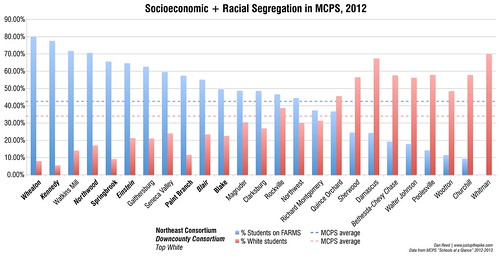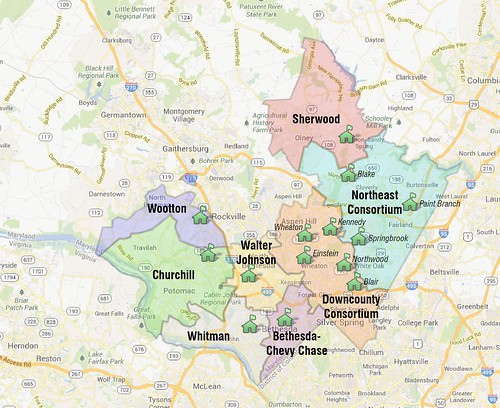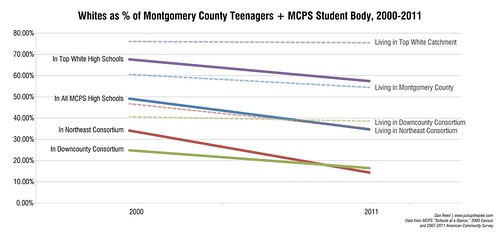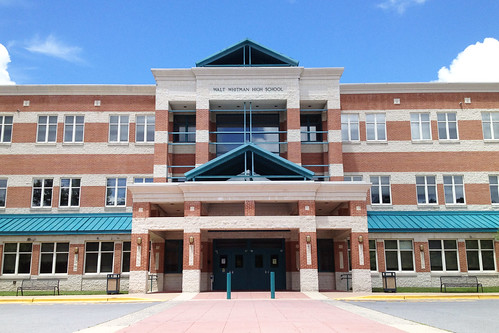First in a series on segregation and academic equity in MCPS. Check out part TWO | part THREE | part FOUR
Montgomery County Public Schools are often regarded as one of the best school systems in the nation, with schools routinely topping regional and national rankings. But as the county grows more diverse, MCPS is becoming a system of haves and have-nots.
In recent years, MCPS has experienced dramatic demographic shifts. In 2000, MCPS was predominantly white. Today, 2/3 of its 149,000 students are racial or ethnic minorities. 42% have at one time received free or reduced lunch (FARMS), a measure of poverty.
But those demographic changes haven't occurred equally across the county. Despite claims to the contrary, who you are and where you live in Montgomery County is the best indicator of what kind of education you'll get.
Increase in minority, low-income students concentrated in East County
Nowhere has the makeup of MCPS changed more than in the Northeast and Downcounty consortia, which were established in the late 1990's in an attempt to promote racial and socioeconomic integration in the county's east side. 8th graders living in the Northeast Consortium are allowed to pick between Blake, Paint Branch and Springbrook high schools, while in the Downcounty Consortium, they choose between Einstein, Northwood, Kennedy, Wheaton and Blair, which is also a magnet school.
Over the past 15 years, they've experienced massive increases in low-income students and drops in white students. Today, the 8 consortia schools contain almost half of the county's black, Hispanic and low-income students in a system with 26 high schools. Minorities make up at least 75% of the student body at each school. Nearly 80% of students at Wheaton and Kennedy high schools are on reduced lunch, while 10% of the county's black students attend Paint Branch.
Meanwhile, 6 top-ranked high schools contain a plurality of the county's white students: Sherwood, Bethesda-Chevy Chase, and the vaunted "W schools," Winston Churchill, Walter Johnson, Walt Whitman and Thomas Wootton. We'll call these the "Top White" schools.
Black, Hispanic and low-income students are a small minority at "Top White" schools, and in the case of Whitman, almost nonexistent. While they've all lost some white students in past years, the proportion of low-income students barely changed.
MCPS is growing, but white flight is occurring too
To an extent, these changes reflect the demographic shifts of the county as a whole, which became a majority-minority jurisdiction for the first time in 2010. MCPS is also growing, and demographer Bruce Crispell estimates that as many as 85% of the county's kids attend a public school, compared to 80% in 2000.
If more students are attending MCPS, one might assume that it would look more like the county as a whole. But the gap between how many white students are in MCPS and how many live here is large and growing. Between 2000 and 2011, the percentage of teenagers living in Montgomery County who were white fell from 60% to 54%, while the proportion of white students in MCPS high schools fell from about 50% to 33%.
This suggests that white families either have left MCPS or moved to higher-ranked schools while other families take their places.
Your income level determines the quality of your school
Like most public school systems, MCPS school assignments are based on where a student lives. This results in what education analyst Michael Petrilli calls "private public schools": high-ranked schools that serve few or no low-income students because the surrounding neighborhoods are prohibitively expensive.
According to local agency MoCoRealEstate, the median sales price of a home in the Whitman cluster was $860,000 last year. That's compared to $330,000 in the Northeast Consortium and $322,000 in the Downcounty Consortium.
Though MCPS boasts a high graduation rate, just 74% of students at Wheaton graduate within 4 years, below state and national averages. 1 out of every 8 students at Wheaton and Northwood drop out each year. But nearly all students in the "Top White" schools graduate on time.
MCPS officials boast that every school offers Advanced Placement classes, a sign of academic rigor, but consortia students failed 60% of their AP exams last year. While most high school students countywide failed their math exams this year, the failure rate was much higher in the consortia. 4 out of every 5 students at Wheaton failed their math exams, compared to just 17% at Whitman.
There's evidence that segregation has had a negative effect on student performance. A recent study from the County Council's Office of Legislative Oversight revealed that black, Hispanic and low-income students are falling further behind white and Asian students in performance on AP tests and the SAT.
It's not that low-income or minority students are inherently inferior. But they often lack access to amenities like early education that can't be made up at school, especially when that school is dominated by kids with the same needs. Studies show that students of all socioeconomic backgrounds do better in a mixed environment, which I'll talk about in future posts.
Montgomery's future depends on its schools
This isn't a new problem. A 1994 study from the Harvard Project on School Desegregation found that past attempts at desegregation were ineffective, but MCPS administrators were unwilling to admit it. "The county's progressive image has created a fierce resistance to serious analysis of rapidly changing conditions," wrote author Gary Orfield.
If administrators seriously want to help their low-income and minority students, they can't continue to ghettoize them in a handful of schools. Otherwise, MCPS will become a two-tier system, with a small group of highly-ranked, predominantly white and affluent schools, and another group of lower-ranked, predominantly poor and minority schools.
MCPS is also integral to economic development. The county's efforts to revitalize East County neighborhoods, like Wheaton or White Oak, hinge on the perception of its most troubled schools.
How did this happen? And what can we do about it? Over the next few days, I'll try to answer those questions, starting with a look at the the county's experience with school choice.
Montgomery County Public Schools are often regarded as one of the best school systems in the nation, with schools routinely topping regional and national rankings. But as the county grows more diverse, MCPS is becoming a system of haves and have-nots.
 |
| Low-income students and white students are each concentrated in separate MCPS high schools. |
In recent years, MCPS has experienced dramatic demographic shifts. In 2000, MCPS was predominantly white. Today, 2/3 of its 149,000 students are racial or ethnic minorities. 42% have at one time received free or reduced lunch (FARMS), a measure of poverty.
But those demographic changes haven't occurred equally across the county. Despite claims to the contrary, who you are and where you live in Montgomery County is the best indicator of what kind of education you'll get.
Increase in minority, low-income students concentrated in East County
Nowhere has the makeup of MCPS changed more than in the Northeast and Downcounty consortia, which were established in the late 1990's in an attempt to promote racial and socioeconomic integration in the county's east side. 8th graders living in the Northeast Consortium are allowed to pick between Blake, Paint Branch and Springbrook high schools, while in the Downcounty Consortium, they choose between Einstein, Northwood, Kennedy, Wheaton and Blair, which is also a magnet school.
 |
| East County and Downcounty schools have experienced huge demographic shifts, while others haven't. |
 |
| A map of the Northeast and Downcounty consortia and "Top White" school clusters. Click for an interactive map. |
Meanwhile, 6 top-ranked high schools contain a plurality of the county's white students: Sherwood, Bethesda-Chevy Chase, and the vaunted "W schools," Winston Churchill, Walter Johnson, Walt Whitman and Thomas Wootton. We'll call these the "Top White" schools.
Black, Hispanic and low-income students are a small minority at "Top White" schools, and in the case of Whitman, almost nonexistent. While they've all lost some white students in past years, the proportion of low-income students barely changed.
MCPS is growing, but white flight is occurring too
To an extent, these changes reflect the demographic shifts of the county as a whole, which became a majority-minority jurisdiction for the first time in 2010. MCPS is also growing, and demographer Bruce Crispell estimates that as many as 85% of the county's kids attend a public school, compared to 80% in 2000.
 |
| Where the white kids are, in MCPS (solid lines) and in Montgomery County (dotted lines). The growing gaps suggest white flight. |
This suggests that white families either have left MCPS or moved to higher-ranked schools while other families take their places.
Your income level determines the quality of your school
Like most public school systems, MCPS school assignments are based on where a student lives. This results in what education analyst Michael Petrilli calls "private public schools": high-ranked schools that serve few or no low-income students because the surrounding neighborhoods are prohibitively expensive.
 |
| With no low-income students, Walt Whitman High School in Bethesda is a "private public school." |
According to local agency MoCoRealEstate, the median sales price of a home in the Whitman cluster was $860,000 last year. That's compared to $330,000 in the Northeast Consortium and $322,000 in the Downcounty Consortium.
 |
| High home prices mean low-income students are virtually shut out of many MCPS school catchments. |
Though MCPS boasts a high graduation rate, just 74% of students at Wheaton graduate within 4 years, below state and national averages. 1 out of every 8 students at Wheaton and Northwood drop out each year. But nearly all students in the "Top White" schools graduate on time.
 |
| More students are suspended, withdraw from school or drop out entirely in consortia high schools. |
MCPS officials boast that every school offers Advanced Placement classes, a sign of academic rigor, but consortia students failed 60% of their AP exams last year. While most high school students countywide failed their math exams this year, the failure rate was much higher in the consortia. 4 out of every 5 students at Wheaton failed their math exams, compared to just 17% at Whitman.
 |
| AP and math exam failures are dramatically higher at low-income schools. |
There's evidence that segregation has had a negative effect on student performance. A recent study from the County Council's Office of Legislative Oversight revealed that black, Hispanic and low-income students are falling further behind white and Asian students in performance on AP tests and the SAT.
It's not that low-income or minority students are inherently inferior. But they often lack access to amenities like early education that can't be made up at school, especially when that school is dominated by kids with the same needs. Studies show that students of all socioeconomic backgrounds do better in a mixed environment, which I'll talk about in future posts.
Montgomery's future depends on its schools
This isn't a new problem. A 1994 study from the Harvard Project on School Desegregation found that past attempts at desegregation were ineffective, but MCPS administrators were unwilling to admit it. "The county's progressive image has created a fierce resistance to serious analysis of rapidly changing conditions," wrote author Gary Orfield.
If administrators seriously want to help their low-income and minority students, they can't continue to ghettoize them in a handful of schools. Otherwise, MCPS will become a two-tier system, with a small group of highly-ranked, predominantly white and affluent schools, and another group of lower-ranked, predominantly poor and minority schools.
MCPS is also integral to economic development. The county's efforts to revitalize East County neighborhoods, like Wheaton or White Oak, hinge on the perception of its most troubled schools.
How did this happen? And what can we do about it? Over the next few days, I'll try to answer those questions, starting with a look at the the county's experience with school choice.

14 comments:
Dan - Great article! This is eye opening as a long-time resident (Blair alum) and now starting my own family in SS.
What are your thoughts on the pockets of consortium elementary schools that 'buck the trend'?
Also, do you think the pre-K programs will have an effect on middle/high school performance in the future?
Dan, probably you remember my infamous "single white female? don't count on it" blog post back in maybe 2008 or so. My how time flies.
I pointed out that Brookhaven Elementary School had a total of 38 white students of both genders in all grades combined, in a school student body of about 300.
I also mentioned that that if this was the 1970s, students would have been ordered bussed to other schools. Heck, there might even have been riots and marching on the basis of that sort of truly outrageous racial segregation.
At the time, I seem to recall you gloating something to the effect of "so how does it feel to be outnumbered?" and the County couldn't give a damn because after all it was me mentioning it.
Careful there, or they'll start calling you a racist, too, for having dared to notice.
Kudos for daring to take the risk.
This raises important questions about racial integration in our schools and school performance. Will be interested to see what solutions Dan proposes.
Dan,
Thanks for amplifying this issue. Im not certain that re-re-engineering and intergrating schools is the ultimate answer, (Not that you suggested it, but others surely will).
The way forward will in part require a way of "seeing and relating" to each other that we have not experienced before.
In Japan right now. Will call you when I return next week.
Ronnie Galvin
I just saw an amazing presentation about the "achievement gap". I think anybody interested in the topic of race and education will find it thought-provoking.
Here is a link to it:
http://vimeo.com/25599183
~Elizabeth
Great article. This is the sort of investigative journalism I'd expect to see in the WaPo. (Especially your note about planning to do a series on this.) Have they ever approached you about writing for them/have you ever applied?
Awesome graph. Excellent graph, if your point is to illustrate that white kids aren't on FARMS.
Gee, how did that happen?
The MC Council is proposing zoning changes that will exacerbate these numbers and increase segregation.
Residential neighborhoods located near bus lines in East and Down county are slated to lose certain residential protections in an effort to increase housing density and provide more low income multi-family housing.
Councilmembers are patting themselves on their collective backs, calling it "smart growth' , while protecting the squires in the agricultural preserve and keeping bus lines demed necessary for low income housing out of wealthier leafier areas.
Basically, people with small back yards are to see multiple family housing go up, whereas people with huge acreage are not expected to have their zoning changed to accomodate growth and newcomers.
( The mobility rate goes up with the proportion of multiple housing and rental units. Mobility rates also indicate what percentage of students moved into a school or left it DURING the school year, not over the summer.) These staggering mobility numbers make it difficult for schools and students to succeed. Thank you for the clear graphics depicting these mobility rates.
Dan - excellent post! Great info. Very interesting read.
Great article, man, but just so you know I am not sure that map is quite accurate. Sherwood covers more area than it should, a good chunk of the southwest part of Olney attends Magruder and a good bit of the southeast of Olney (mostly Hallowell) goes to Blake.
Why are those posting dancing around the obvious!!!! There is inequality occurring in Montgomery County Schools, my two older kids came up through MCPS they are both in college now. There has definitely been a trend over the past two decades of the eastern part of the county becoming more African American and Hispanic, and the western part of the county more White and Asian. One could argue that as long as resources in each school is equivalent its not an issue. However I believe our kids suffer developmentally by not having the opportunity to experience diversity which is more reflects the real world.
http://www.flickr.com/photos/thecourtyard/9134267991/
Shows no Northwood HS (where I use to attend. Also, I now live in Howard County, so in the future, please (once) explain what FARM means, as it's used quite a bit. I've never heard of it and would make your charts more meaningful.
Thanks
Great article! I know I'm really late to this party, but FARMS means "Free and Reduced Meals."
Certainly segregation is a problem. I've had an interesting vantage point on this issue as an elite African-American tutor with experience catering to the Whitman/Churchill market early in my career. Do you feel that our focus should be on the immensely challenging political issue of desegregating our schools or challenging families with resources with who prefer segregation to subsidize public schools in the higher needs areas with the types of tutoring resources that they are able to provide for their children? It's important to realize that MCPS' vaunted SAT scores and AP scores in the higher income areas reflect in part how it benefits from families choosing to supplement around its weaknesses.
Post a Comment